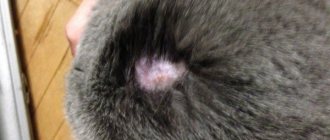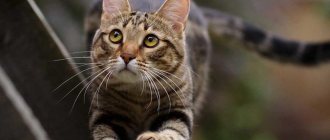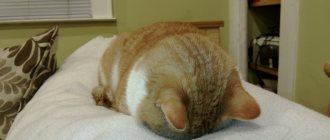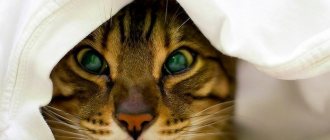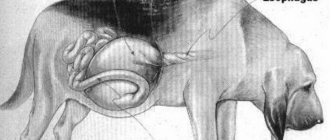Causes of hepatitis
Causes of hepatitis in cats:
- Infections. Infectious hepatitis in cats develops as a complication of viral, fungal and bacterial infections (leptospirosis, panleukopenia, toxoplasmosis and chronic viral infections). Viral hepatitis does not exist as an independent disease in cats, unlike infectious adenoviral hepatitis in dogs.
- Autoimmune diseases.
- Toxins. Toxic hepatitis in cats can occur as a result of acute poisoning with poisons, chemicals, low-quality food (for example, if storage conditions are not met and the food is contaminated with fungal flora), medications, etc. All toxic substances that enter the animal’s body pass through the bloodstream through the liver, whose cells cleanse the blood of harmful components.
- Diseases accompanied by abnormal accumulation of copper in the liver.
- Due to the action of certain medications.
Prevention
As you know, the best treatment is prevention. Be sure to vaccinate your cat against hepatitis - do not wait until your pet becomes infected. In addition, the following rules for preventing this disease will help you:
- Vaccinate your animal on time. This will allow the immune system to develop and resist various pathogens. The stronger the immune system, the less the liver participates in protecting the body.
- Drive worms according to the schedule (quarterly).
- Do not feed raw fish or meat to your pet. This can lead to an infectious or parasitic disease (for example, opisthorchiasis).
- Do not feed spoiled food (sour, moldy).
- Don't feed fatty foods.
- Do not self-medicate. Or follow the dosage and frequency of administration of the drugs prescribed by your veterinarian.
- Do not keep your pet in poorly ventilated areas (especially if the house is being renovated). Keep all potential poisons (household chemicals, paints, fuels, solvents, pesticides, herbicides, etc.) out of reach of your pet.
- If you are treating the mustache for skin parasites or washing it, then be careful. Do not exceed the dosage of the drug. And wash off cosmetics thoroughly.
- Do not allow your cat to come into contact with homeless or suspicious animals. Such communication is potentially dangerous (there is a risk of contracting infectious or parasitic diseases).
We hope the article helped you! If you have any questions about hepatitis in cats, write in the comments!
Clinical symptoms of hepatitis
Symptoms of hepatitis in cats are nonspecific; not all symptoms may appear, since their presence depends on the stage of development of the inflammatory process in the liver:
- lethargy;
- loss of appetite;
- weight loss;
- vomit;
- increased urination and thirst (polydipsia/polyuria);
- icteric staining of the gums and other mucous membranes;
- accumulation of free fluid in the abdominal cavity (ascites);
- neurological symptoms due to increased concentrations of ammonia in the blood (hepatic encephalopathy).
Most often, two types of hepatitis occur in cats: cholangiohepatitis
(acute and chronic) and
lymphocytic portal hepatitis
.
Description
Hepatitis is an inflammatory liver disease. As a result of pathological processes, healthy cells are replaced by connective tissue, which reduces the functionality of the organ. Among other tasks, the liver cleanses the blood of waste products and is involved in the metabolism of proteins, hormones, vitamins, and glucose.
If the functioning of the organ is not restored, inhibition of these processes will lead to death. As in humans, feline hepatitis occurs in acute and chronic forms - both are equally dangerous. In the first case, death without treatment occurs within days, and chronic hepatitis in a cat can last for years. But without therapy, the result is the same.
Many owners worry whether cats suffer from hepatitis C and other viral forms. Fortunately, this is out of the question. Some viruses (calcivirus, plague, coronavirus) lead to inflammatory processes. But cats do not have viruses that directly infect the liver (as in people A, B, C...).
There is also no need to worry about whether hepatitis is transmitted to humans from cats. Other pets, children, even family members weakened by chronic illnesses are safe. However, personal hygiene rules still need to be observed, since inflammation is often accompanied by secondary infections (fungi, bacteria).
Cholangiohepatitis
Cholangiohepatitis is an inflammation of the liver and bile ducts.
The wide prevalence of cholangiohepatitis in cats is associated with the peculiarities of their anatomy: the pancreatic duct and the gallbladder ducts connect before emptying into the duodenum. Therefore, inflammation of the small intestine or pancreatitis (inflammation of the pancreas) also leads to inflammation of the bile ducts (cholangitis).
Cholangiohepatitis can manifest itself in acute and chronic forms.
The acute form occurs more often in young cats. It begins with a sudden refusal to feed and lethargy. Vomiting appears, body temperature often rises, and the abdominal area is painful. With acute hepatitis, dehydration quickly occurs. After this, the so-called “jaundice” or icterus (yellowish tint of the skin and mucous membranes), which is noticeable on the sclera of the eyes and gums. During this period, the activity of liver enzymes, bilirubin and the number of leukocytes in the animal’s blood increases.
The chronic form of cholangiohepatitis is more common than the acute form, and older cats are more prone to it. Symptoms with this course appear and disappear in periods, with periods of exacerbation often associated with stress.
Depending on the type of cells that are found during microscopy of liver samples, chronic cholangiohepatitis may have different names. If lymphocytes predominate, it is called lymphocytic cholangiohepatitis; if neutrophils - then neutrophilic; if other defense cells (macrophages, plasmacytes) – then granulomatous.
All forms of cholangiohepatitis can eventually lead to liver atrophy (cirrhosis).
The causes of acute cholangiohepatitis are often bacterial infections that pass to the liver from the small intestine (duodenum) and pancreas. In addition, acute cholangiohepatitis can be caused by coronavirus infection, intoxication, or feeding with low-quality or unbalanced feed.
Among the causes of chronic cholangiohepatitis, genetic predisposition comes first; it can also be due to an autoimmune disease, helminthiasis, cystoisosporosis, or malnutrition.
Liver functions
Let's start with the basics in order to understand the full scope of the situation. Let's figure out what functions the liver performs in cats.
Digestive and metabolic regulating
The liver is also involved in the digestion process, although it is more accurate to say that this organ is a connecting link between the digestive and circulatory systems. Proteins and fats are broken down thanks to the work of the liver (however, it not only breaks down incoming substances, but also forms new ones necessary for life). Don’t forget about glycogen, which is stored until “rainy days.” In addition, the liver regulates the release of hormones (in particular, adrenaline and norepinephrine).
Formation and secretion of bile
And it is excreted into the duodenum. It is what helps break down food (however, it performs several other functions, which you will learn about in the text below). Bile is formed in liver cells using blood. When hemoglobin is broken down, bilirubin is formed, which is the bile pigment. Bile helps activate enzymes (in particular lipase), which break down food.
Absorption of fats and synthesis of vitamins
Rather, this function can be “assigned” to bile, which (as already written above) emulsifies fats. But they can be absorbed only after they combine with bile acids. After the gallbladder “gives up” the secretion accumulated in it, the intestines begin to contract better (peristalsis increases, which contributes to the normal movement of food through the gastrointestinal tract).
Vitamin A is formed in the liver, and vitamin K and nicotine are also “stored”.
Regulating Blood Glucose Levels
The next function of the liver “follows” from the previous paragraph – regulation of glucose levels in the blood. As soon as it rises, the liver immediately begins to make “reserves”, forming and storing glycogen. When there is not enough glucose, these reserves are destroyed, as a result, blood sugar returns to normal. However, if your pet has problems with the concentration of glucose in the blood, but the liver is absolutely healthy, then most likely the cat has diabetes.
"Purification" and "storage" of blood
Excessive amounts of medications/hormones/vitamins, metabolic “waste” - all this “settles” in the liver. But if too much of this “nasty” accumulates, the liver begins to die, and the toxins are again spread through the blood throughout the body, poisoning it. The liver is well supplied with blood vessels. Blood not only passes through this organ, as if through a filter, but is also retained. Therefore, if as a result of an injury there is severe blood loss, then the liver “gives up” its reserves in order to somehow replenish the volume of circulating blood.
Protective function
This is not only about cleansing the blood of toxins, but also about disinfecting it from bacteria. The liver, “sacrificing” itself, retains microorganisms to the maximum (cells are capable of phagocytosis). Therefore, even if a pet gets sick with salmonellosis (or another microbe decides to “annoy” the mustache), the liver suffers. And the veterinarian, having noticed the symptoms of an infectious disease, as well as signs characteristic of liver inflammation, will probably tell you that the cat has viral hepatitis. And this is not due to poor qualifications of the specialist or lack of experience, no, this diagnosis is general. Like ARVI in our country. The doctor does not say which pathogen led to inflammation of the respiratory tract in us; the same can be said about viral hepatitis in cats.
Why is a liver needed? Take a look at this short and clear video:
Complications of hepatitis
- Hepatic lipidosis.
Cats do not tolerate periods of not eating well (anorexia). At this time, their liver often begins to store fat, which leads to lipidosis; the functional liver tissue is irreversibly replaced by fatty tissue. Cats with a lack of appetite due to cholangiohepatitis are at risk. - Hepatic encephalopathy.
Due to increased levels of ammonia and other unwanted components in the blood, brain damage occurs. - Portal hypertension
and the formation of free fluid in the abdominal cavity (ascites). - Sometimes chronic cholangiohepatitis progresses to cancer. In humans, there has been a proven connection between chronic stimulation of lymphocytes and the occurrence of malignant lymphoma. Therefore, it is likely that chronic lymphocytic cholangiohepatitis in cats can provoke lymphoma and malignant abnormalities of lymphocytes.
Diagnosis of hepatitis
- General clinical examination of the animal.
- General clinical and biochemical blood test. The presence of hepatitis or chronic inflammation of the intestines and pancreas is indicated by a high level of GGT, an increase in ALT and alkaline phosphatase with normal levels of thyroid hormones. The level of bilirubin and globulins also increases, cobalamin and folic acid decrease.
- Serological studies. Used for suspected viral infections (feline leukemia, feline immunodeficiency, feline viral peritonitis), as well as toxoplasmosis.
- X-ray examination.
- Ultrasound of the abdominal cavity (is important in diagnosing cholangiohepatitis or obstruction (blockage) of the bile duct).
- Liver biopsy. A needle is inserted through the abdominal wall into the animal's liver and material is collected for further research. The best way to diagnose hepatitis is by examining small pieces of the animal's liver. They are obtained by exploratory laparotomy (surgically) or by biopsy. Both procedures pose a certain risk and must be carried out with extreme caution, because in severe cases of the disease, the affected organs may bleed during puncture, and anesthesia poses a risk to the sick animal.
- Bacterial culture of liver and bile. If liver and bile samples can be obtained for pathological examination, it may be possible to test them for the presence of bacteria.
Diagnostics
Kidney disease in cats: symptoms and treatment
Making a diagnosis begins with examining the animal. If signs are found that allow one to suspect hepatitis in a cat, a referral for additional tests may be issued.
A painless ultrasound procedure allows you to make an accurate diagnosis
Laboratory testing of blood and urine helps to exclude or confirm the fact of the inflammatory process. Some changes are necessarily observed with hepatitis, although they are not a condition for diagnosis. Pathological changes in the thickness of the walls of internal organs, the proportions will be shown by ultrasound.
Treatment
- stabilization of the body's condition in critical cases (intravenous therapy with electrolyte solutions). If necessary, artificial or parenteral nutrition and antiemetics are prescribed;
- antibiotics;
- choleretics and hydrocholeretics (substances that help the passage of bile from the liver to the intestines). They are prescribed to prevent bile stagnation, because this is one of the main phenomena of cholangiohepatitis;
- anti-inflammatory drugs;
- immunosuppressants (prescribed for lymphocytic portal hepatitis);
- vitamins K, E, B12. With cholangiohepatitis, the ability to absorb these vitamins through the intestines is reduced. In some cases, the use of taurine, folic acid and L-carnitine is also indicated.
Hepatitis treatment
Any actions aimed at combating the pathology must be coordinated with a veterinarian. Therapeutic manipulations consist of the use of the following drugs:
- Antidotes. If the disease is caused by intoxication of the body, Vikasol and products containing vitamin K will help reduce the level of poison in the blood.
- Infusion therapy. Dehydration is treated with glucose and rehydration solutions.
- Hepatoprotectors. Essentiale Forte and Karsil have a supporting effect. Taking B vitamins is also helpful.
- Antispasmodics. For analgesic purposes, Drotaverine and No-shpu are used.
- Antiemetics. "Metaclopromide" successfully copes with this task.
- Immunocorrectors. The body's protective barrier is increased by Gamavit , Cycloferon, Phosprenil and Immunofan.
- Antibiotics. Pathogenic microorganisms are inhibited by Amoxisan.
- Antihistamines. For hepatitis of allergic origin, Suprastin and Diphenhydramine are used.
Taking medications is possible only as prescribed by the attending physician. You should adhere to the dosage indicated in the instructions.
The basis of therapy is the use of medications
Medical nutrition
Any therapeutic measures will be ineffective if the pet is not switched to a gentle diet.
1 day. The pet should fast for the first 24 hours. Only drinking plenty of fluids is possible.
Day 2. Finely chopped beef tenderloin and low-fat broth. Fatty foods, chicken, vegetables, fruits and fish are prohibited.
Day 3. Boiled rice, cooked without the use of salt or oil. If your cat has lost a lot of weight, rice can be replaced with oatmeal. If there is no vomiting, you can add a small amount of pate.
During the diet, the consumption of mucous porridges is allowed
4–5 days. Low-fat fermented milk products - yogurt and cottage cheese. You need to monitor the body’s reaction and, if necessary, exclude them from the diet.
During treatment, fermented milk products of exceptionally low fat content should be given.
6–7 days. Chopped boiled vegetables. The ideal option would be carrots grated with cottage cheese.
Eating potatoes is not recommended for hepatitis
Then you can transfer the animal to a regular diet, focusing on the use of medicinal dietary feed. To reduce the load on the organ, fractional feeding in small portions 5 times a day is used. Due attention should be paid to the animal's fluid intake. To prevent dehydration, your cat should always have access to a bowl of water. Veterinarians also recommend feeding your pet with Regidron.
"Regidron"
Owners of cats who prefer a natural feeding system should exclude foods containing a high percentage of fat from the diet.
Diet
The cat should be switched to a diet containing a reduced amount of sodium, carbohydrates and an increased amount of protein. It is not advisable to feed your animal food containing sucrose or fructose.
To avoid hepatic encephalopathy, if the level of ammonia in the blood of a particular animal is elevated, the amount of protein in its diet should be limited, because Protein is the main source of ammonia in the body.
It is very important to feed your cat small meals multiple times throughout the day.
Prognosis for hepatitis in cats
The liver is an organ that recovers well in the event of a sudden crisis, provided that some of its cells (hepatocytes) remain intact. Therefore, a cat with an acute form of hepatitis is not difficult to cure. However, with chronic hepatitis the situation is different. Diet and proper treatment help improve the animal’s condition, although the chronic form of the disease is not completely cured. The animal can live a normal life if the conditions of detention and therapeutic feeding are observed, although the disease can worsen with any stress.
The prognosis is less favorable for cats with advanced stages of hepatitis, when many systems are susceptible to inflammation and the disease has approached the early stages of leukemia (lymphoma).
Causes of the disease
Many factors influence the condition of the animal’s liver, advancing or delaying the development of pathology. Among them are poor ecology, genetic predisposition to allergies, and recent other diseases.
Location of the liver in felines
Important : proper care of your pet reduces the risk of developing the disease and makes treatment easier.
After an examination, the veterinarian will determine what exactly happened and what treatment will be most effective.
